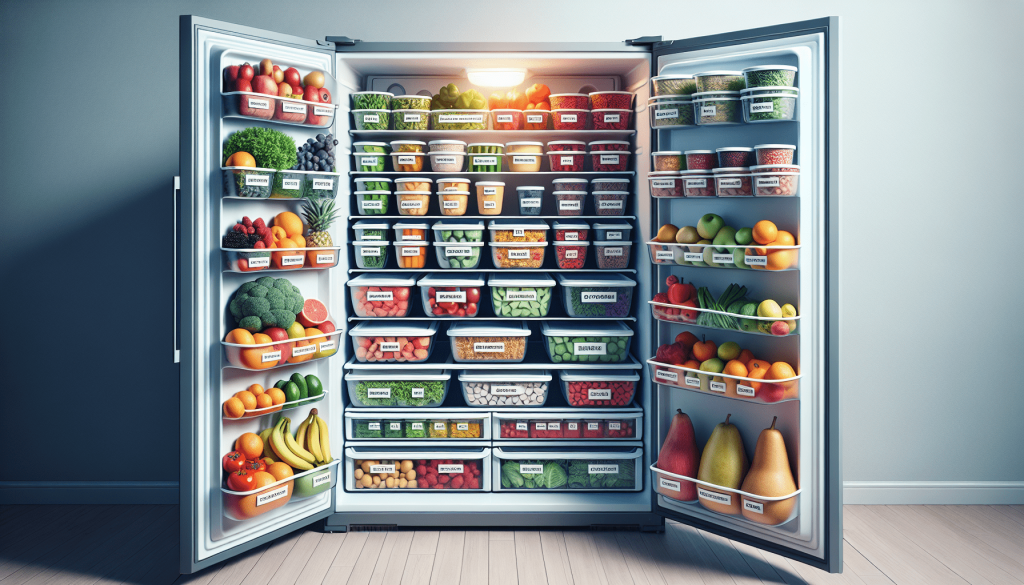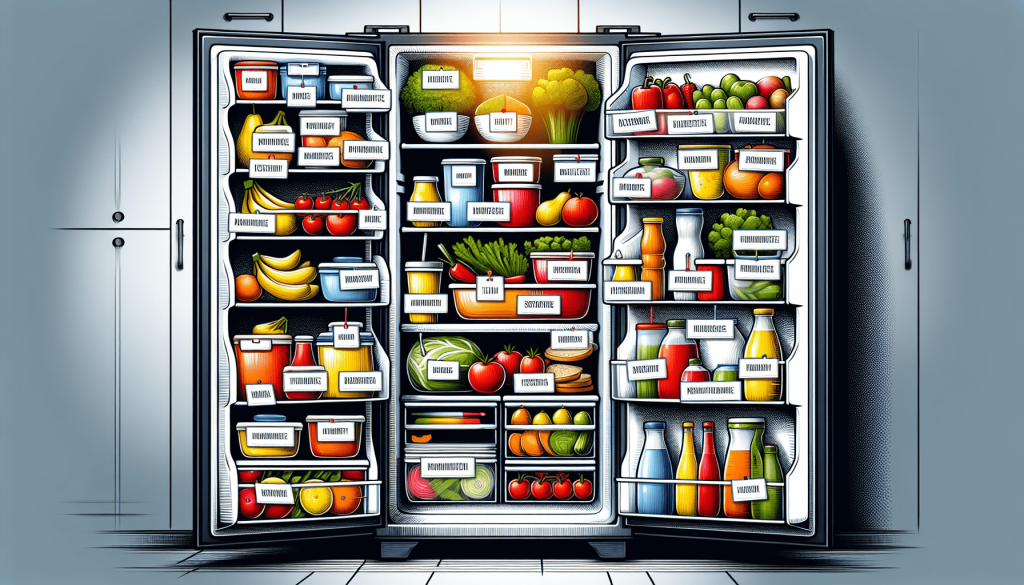Have you ever found yourself digging through a messy refrigerator, struggling to find what you need? Well, fear no more, because “Organizing Your Refrigerator: A Step-by-Step Guide” is here to save the day! In this helpful article, you will discover simple and practical tips on how to transform your fridge into a well-organized oasis of freshness. Say goodbye to food wastage and hello to easy meal planning, as we take you through each step to create a clutter-free and efficient refrigerator that will make your life so much easier. So, let’s get started and turn that chaotic fridge into a beautifully organized masterpiece!

Clearing Out and Cleaning the Refrigerator
When it comes to organizing your refrigerator, the first step is to clear out all items from the refrigerator. This gives you a clean slate to work with and allows you to properly clean each part of the refrigerator. As you remove items, be sure to check for any expired or spoiled food. Dispose of any items that are no longer safe to eat.
After emptying the refrigerator, it’s time to give it a thorough cleaning. Start by wiping down the shelves and drawers with a mild cleaning solution. This will remove any debris or spills that may have accumulated. Next, clean the interior walls and door gaskets to get rid of any lingering odours or stains. Finally, make sure to dry all surfaces thoroughly to prevent moisture build-up.
Categorizing Your Food
Sorting your food items into categories is an essential step in organizing your refrigerator. This makes it easier to find what you need and helps prevent food from getting lost or forgotten. Group similar items together, such as placing all dairy products in one area and condiments in another. Consider creating zones for different types of food, like a designated area for snacks or beverages.
To make things even more organized, label containers and shelves for easy identification. This will help you keep track of what’s in your refrigerator and ensure that nothing goes to waste. Just a simple label or sticker can make a big difference in maintaining a well-organized fridge.
Optimizing Storage Space
Maximizing storage space in your refrigerator is key to keeping everything in order. There are several strategies you can use to achieve this. Firstly, invest in stackable containers or bins. These allow you to utilize vertical space and make the most of the available room. Additionally, consider using lazy susans or turntables for easy access to items that are tucked away in the back.
Adjustable shelves are another great option for optimizing storage space. By adjusting the shelves to fit your needs, you can create more room for taller items or make space for additional containers. Finally, consider installing a door-mounted storage rack. This can be used to store condiments or frequently accessed items, freeing up precious shelf space.
Arranging Items for Optimal Freshness
Properly arranging your items in the refrigerator can help keep them fresh for longer. Begin by placing leftovers and ready-to-eat foods at eye level. This ensures that they are within sight and are more likely to be consumed before they spoil. Raw meat, poultry, and seafood should always be stored on the bottom shelf to prevent any potential cross-contamination.
Fruits and vegetables should be stored in designated crisper drawers to maintain their freshness. These drawers create a controlled environment with adjustable humidity levels, which helps to preserve the quality of produce. Dairy products, on the other hand, should be stored in colder areas of the refrigerator, such as the back or bottom shelf.

Utilizing the Freezer Effectively
The freezer is an essential part of any refrigerator, and organizing it properly can save you time and money. Start by organizing your frozen food by category and date. This makes it easier to find what you’re looking for and ensures that older items are prioritized for use. Use freezer-safe containers or bags for long-term storage to prevent freezer burn and maintain the quality of the food.
Label and date all items in the freezer to keep track of how long they have been stored. This will help you avoid any confusion and prevent the waste of perfectly good food. It’s also important to periodically rotate items in the freezer. This prevents items from being forgotten or left to freezer burn due to prolonged storage in one spot.
Maintaining a Clean and Odour-Free Fridge
Regular maintenance is key to keeping your refrigerator clean and odour-free. Wiping up spills and stains as soon as they occur will prevent them from becoming dried-on and difficult to clean. Keeping an open box of baking soda in your refrigerator also helps to absorb any odours and keep things smelling fresh.
In addition to regular spot cleaning, it’s important to give your refrigerator a thorough clean regularly. This prevents the growth of mould and mildew and ensures that your food stays safe and fresh. Check for expired condiments or any items that have gone bad, and promptly discard them to maintain a clean and healthy refrigerator.
Frequently Reassess and Reorganize
It’s important to regularly reassess and reorganize your refrigerator to maintain its efficiency and effectiveness. Set aside some time on a regular basis to go through your refrigerator and remove any expired or spoiled items. This will help keep your refrigerator clutter-free and reduce the risk of consuming old or unsafe food.
While reassessing, take the opportunity to make adjustments to your organization system if needed. If you find that certain areas are frequently congested or items are difficult to find, consider making changes to improve the flow and accessibility of your refrigerator. It’s all about finding a system that works best for you and your family’s needs.
Keeping track of your food inventory is also useful in meal planning and reducing waste. By knowing what items you have, you can plan meals accordingly and avoid purchasing unnecessary groceries. This not only saves you money but also helps to reduce food waste.
Tips for Avoiding Food Waste
To further minimize food waste, there are a few tips to keep in mind. Keeping track of expiration dates is crucial in ensuring that food is consumed before it goes bad. Plan your meals based on perishable items first to prioritize their usage. Get creative with leftovers and turn them into new dishes to prevent them from going to waste. Finally, consider donating excess food to local food banks or shelters to help those in need.
Maintaining Proper Refrigerator Temperature
Maintaining the proper temperature in your refrigerator is vital for food safety and freshness. Regularly check and adjust the refrigerator temperature to ensure it falls between 1-5°C (34-41°F). This range is ideal for keeping food fresh and preventing the growth of harmful bacteria.
To monitor the temperature accurately, use an appliance thermometer placed in the fridge. This ensures that your refrigerator is functioning properly and maintaining a safe temperature. Overloading your refrigerator can affect its cooling efficiency, so be mindful of how much you are storing and avoid overcrowding.
Safety and Hygiene Practices
Practicing proper food handling techniques is essential for maintaining a safe and hygienic refrigerator. Always follow guidelines for preventing cross-contamination, such as keeping raw meats separate from ready-to-eat foods. Regularly clean the refrigerator handles and exterior surfaces to prevent the spread of bacteria.
Avoid storing non-food items in the refrigerator, as this takes up valuable space and can introduce unnecessary contaminants. It’s important to keep chemicals and cleaning products away from food storage areas to prevent any accidental contamination.
By following these step-by-step guidelines, you can enjoy a well-organized and clean refrigerator. Not only will this make your life easier when it comes to finding and accessing items, but it will also help to reduce food waste and keep your food safe and fresh for longer. So roll up your sleeves, put on some gloves, and give your fridge the TLC it deserves!
